How to combine ‘agile’ and ‘waterfall’ in a single Jira project
Marcin Gebicz, E-Marketer at SoftwarePlant, has submitted this guest blog outlining how to combine agile and waterfall methodologies in a single Jira project. SoftwarePlant were keynote speakers at our Atlassian in Scotland event in Glasgow in March 2019, where they presented on project portfolio management with BigPicture.
Have you ever tried to combine ‘Waterfall’ and ‘Agile’ methodologies in a single Jira project? Senior-level executives like high-level, waterfall tools to keep an eye on deadlines, milestones, goals, and risks. Low-level teams, on the other hand, prefer to plan their sprints on agile boards. Let’s see how to run a project in Jira to address the needs of both groups so that the small tasks belonging to teams form larger chunks digestible by CEOs. And vice versa.
First, let’s assert that the hybrid or mixed project management is hardly feasible without some add-on on top of your Jira. It’s because Jira Software alone has ‘just’ the agile boards, and lacks a timeline-based, waterfall planning tool, such as the Gantt chart. So, as a bare minimum, research Atlassian Marketplace on some Gantt chart app for Jira. Even better, get a full-scale project management add-on, because Jira’s agile boards lack another valuable feature, namely ‘Teams’.
BigPicture is one good example. For the essence of hybrid project management in BigPicture, check the below screenshot:
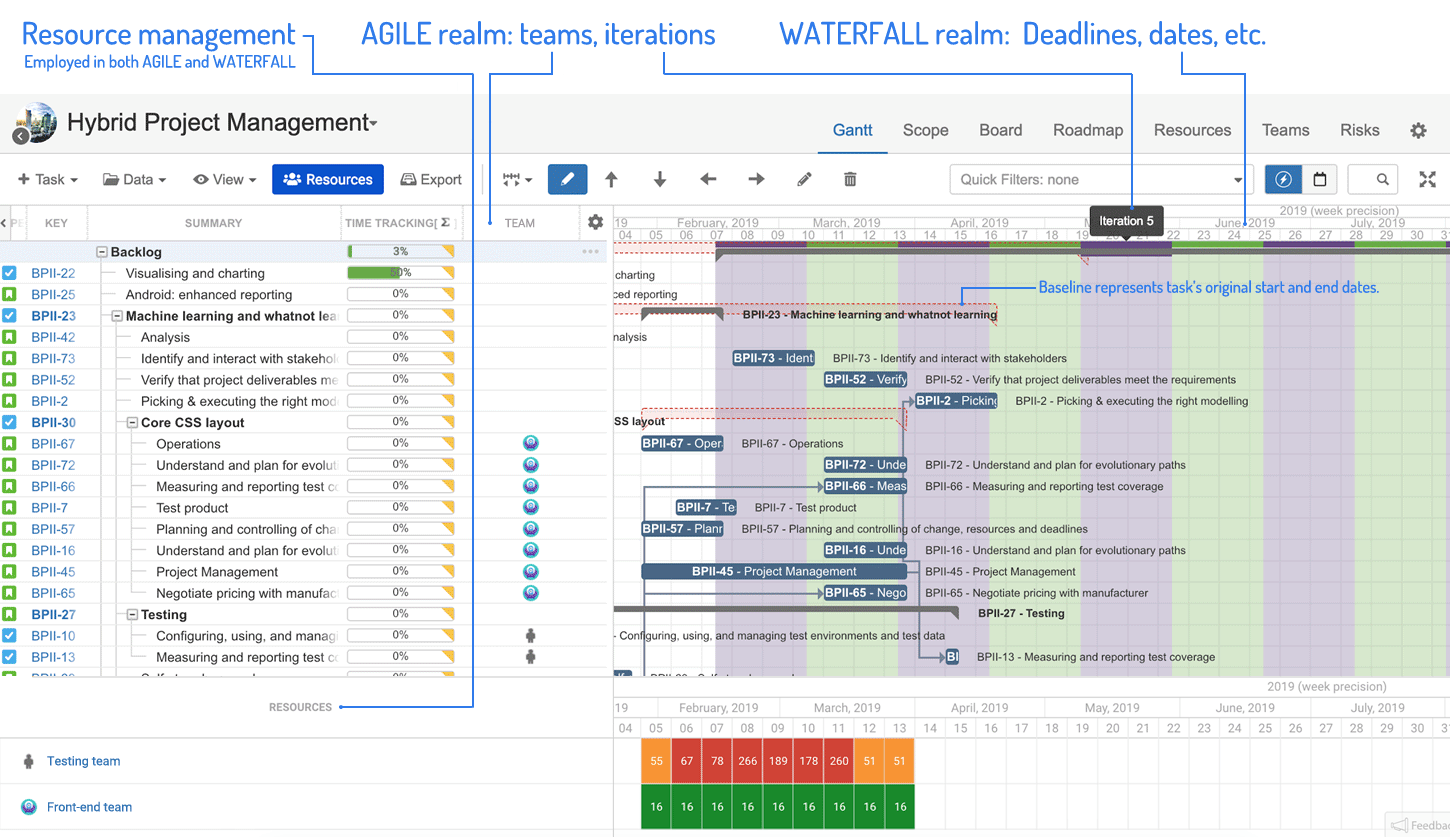
How do agile and waterfall management styles meet together in BigPicture?
Can you recall senior executives from your home organization? Do they rely on dates and deadlines? If so, they might appreciate that they can keep an eye on high-level tasks and milestones (essential dates) sitting on the timeline of the Gantt chart. It is the ‘waterfall part’ of the above screenshot.
To see the ‘agile part’ let’s descend to the teams’ level. Teams across software, finance and healthcare industries, as well as R&D and marketing departments in just about any sector, increasingly rely on two- or three-week iterations. In BigPicture they would typically use an Agile board for planning:
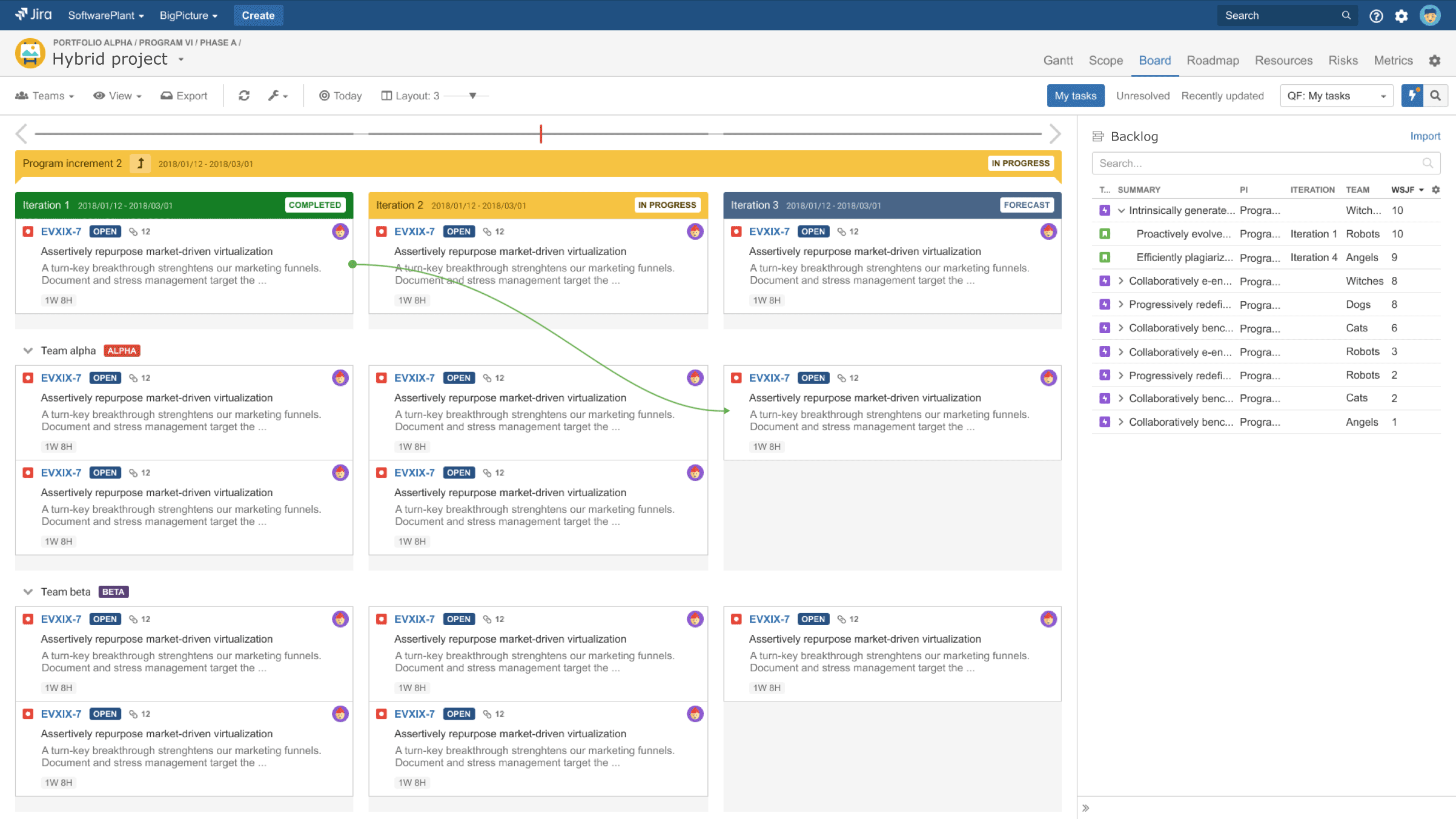
So imagine them moving tasks from the backlog onto the board during their planning session on Monday. Two things would happen on-the-fly:
- the tasks attached to the upcoming iteration on the board become immediately evident on the senior executives’ Gantt chart-timeline (provided they’ve enabled View > Show > Cadences option on the Gantt chart)
- should the teams’ decisions hit the high-level plan, the directors may or may not notice (depending on the ‘task mode’), phases or epics getting rescheduled on their Gantt chart-timeline. Fortunately, the delayed tasks will leave red contours (baselines) behind to represent the original start and end dates of the high-level task.
Check this Step by step tutorial on how to launch and run a mixed agile-waterfall project in Jira and BigPicture.
Other than the above, there are more techniques suitable for hybrid-mixed projects. Let’s go through them one by one:
Have story points (agile) and time tracking (waterfall) in the same view
This is another measure that caters to the HYBRID projects in Jira. Have both ‘Time tracking’ (waterfall) and ‘Story points’ (agile) columns in the same BigPicture view, like we marked on the below Gantt chart:
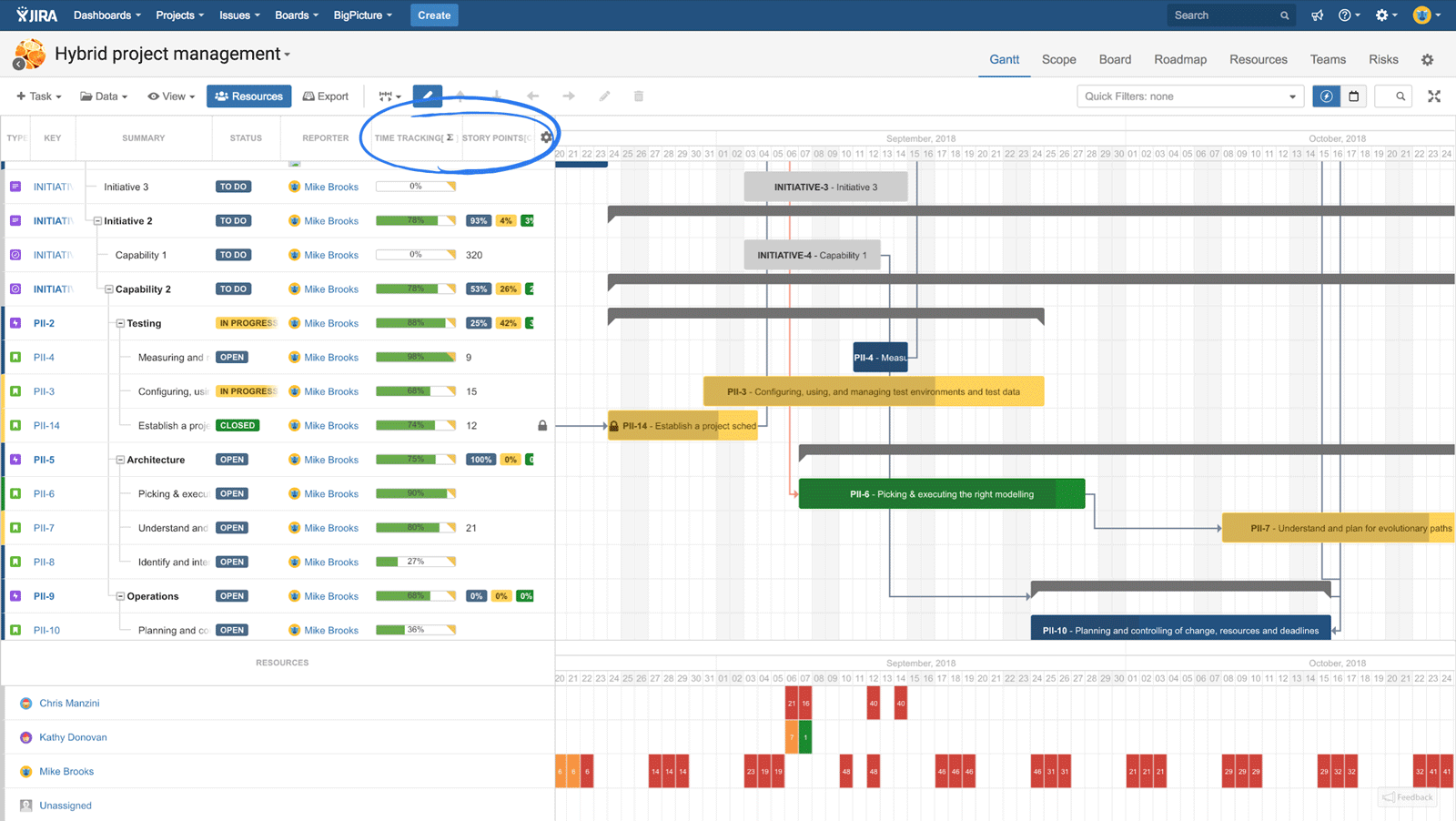
BigPicture’s Scope is another module you can pursue this approach in.
Resources module is very appropriate for hybrid projects
Those PMs who use purely agile software have difficult times allocating their teams’ and team members’ capacity to the standard of 90-110%. Since BigPicture supports the waterfall concepts, it has to have the full-size Resource module, pictured. The intuitive orange, red and green bars lets you visually scan for the areas of underallocation (represented by green) and overallocation (red) of your workforce.
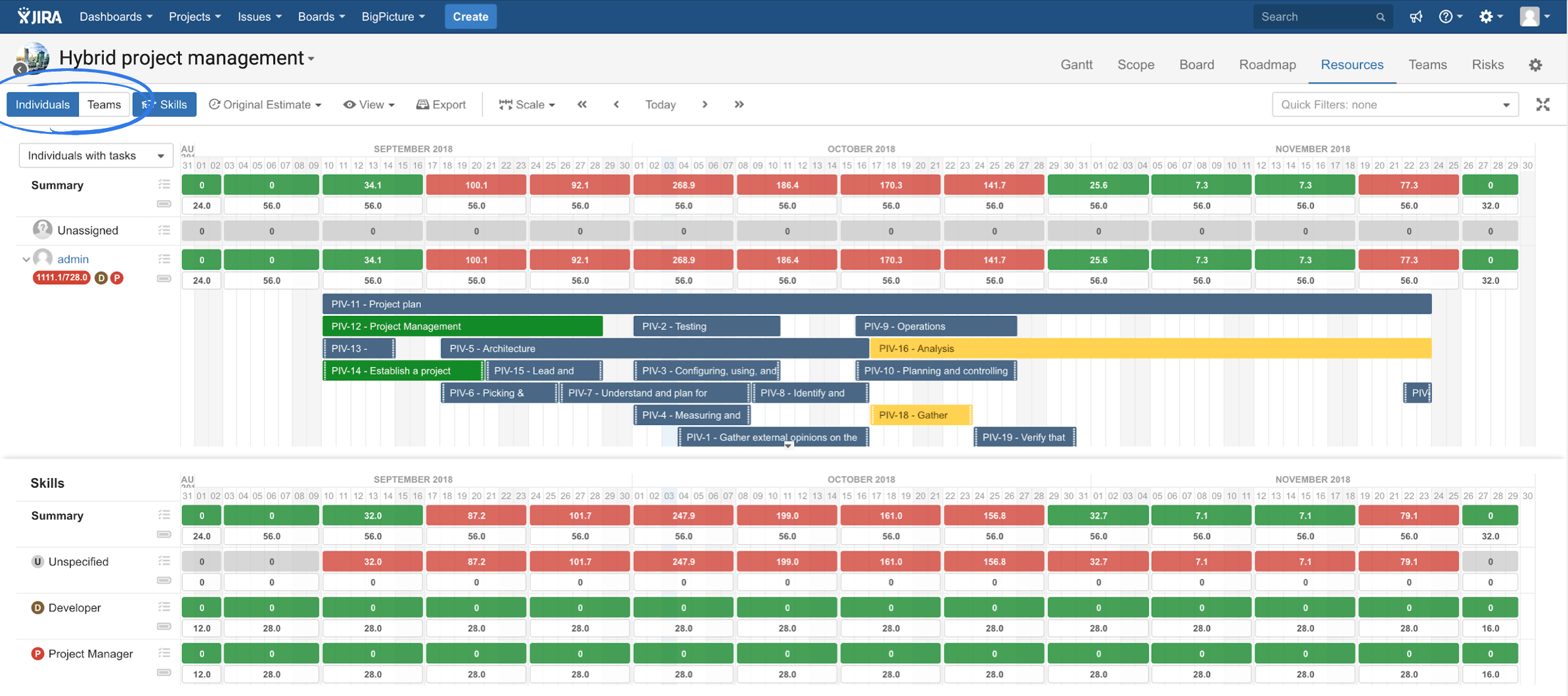
Also, note how you can switch between ‘Individuals’ and ‘Teams’ views. We’ve marked the buttons in the above picture. Agilists involved in your project will appreciate the ‘Teams’ view, while those working the waterfall style will appreciate the classical ‘Individuals’ outlook, enabled in the above screenshot.
Risks in hybrid projects
Does your agile software has some risk management module? It not necessarily does since some agile PM methodologies skip the risks altogether. Fortunately, BigPicture not only has the Risk matrix, but you can configure its axes. Why is the latter crucial in hybrid project management?
Waterfall projects very typically use the following Risk probability matrix: one of the axes represent Risk probability, with values ranging from ‘almost none’ to ‘very high’, and the other one stands for Risk consequence - ‘trivial’ to ‘severe’. This is the default configuration of BigPicture’s Risk module.
Now, let’s throw a glance at an increasingly popular agile methodology - Scaled Agile Framework, with its unique Probability / ROAM axes. As evident in the below picture, the risk matrix in BigPicture has been re-set specifically for SAFe:
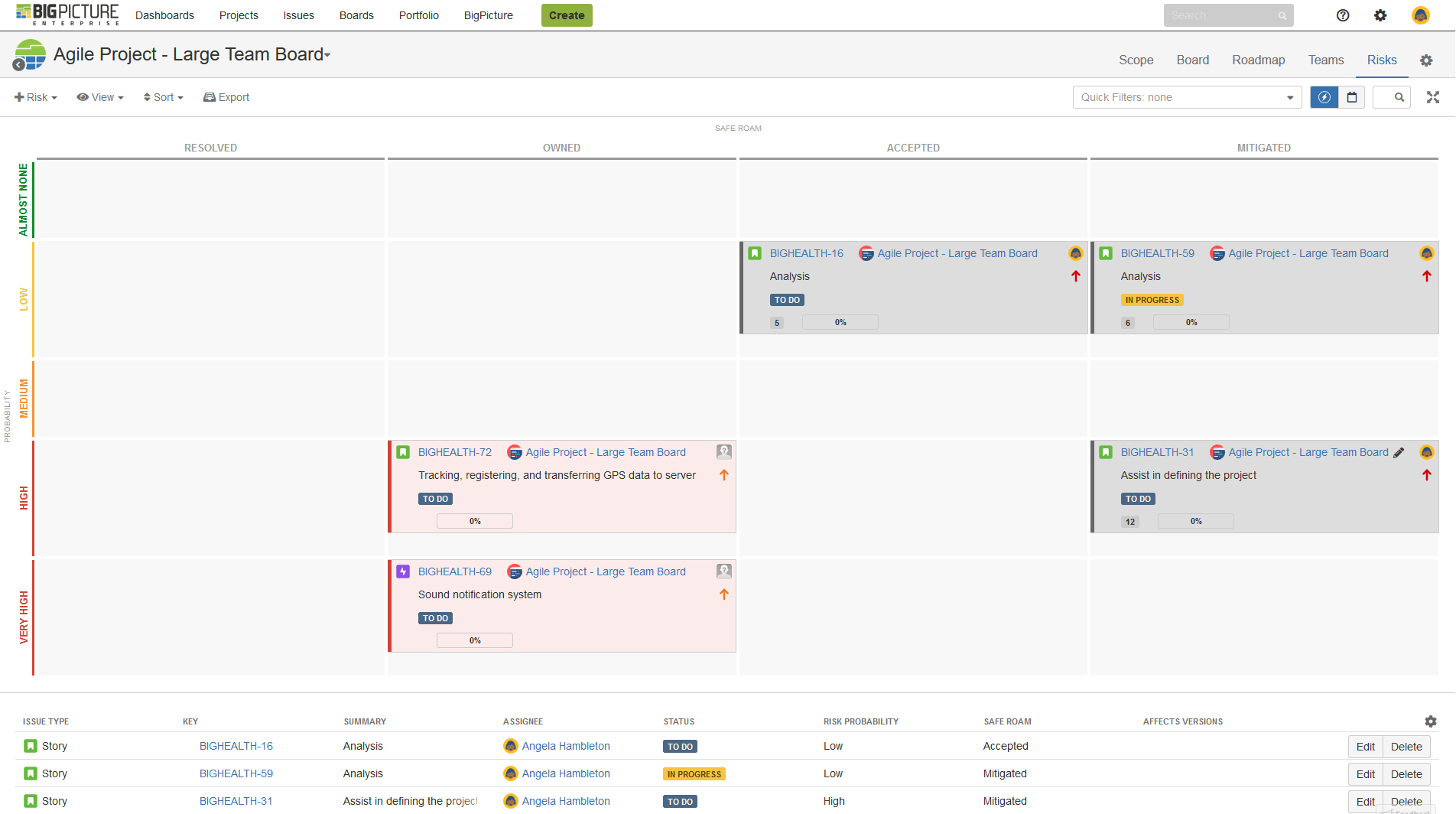
Why is drag&drop crucial in mixed projects?
The ability to drag and drop tasks to reassign them to teams or individuals may seem granted, and it certainly is in modern agile project management software. Step back to some pre-Jira, waterfall applications, though, and you might get surprised by the drag&drop feature missing. And for a reason: back then you would have rarely rescheduled things, once a plan had been approved.
So, it could come as a not-all-that-common combination that BigPicture both supports the waterfall methodologies and it has the precious drag&drop capability - on the Agile Board and Resources module.
Q&A
I’m a PRINCE2 project manager. Should I consider hybrid projects?
PRINCE2 is a waterfall methodology, so a Gantt chart is all a PRINCE2 project needs, right? Not quite. Hybrid projects are applicable here as well. Think of those ‘work packages’ that PRINCE2 project managers pass responsibility for to teams. Why not let teams slice these ‘work packages’ into iterations in an agile manner on a Program board?
A team failed to deliver a task in the current 2-week iteration and put that task off for the next iteration using their beloved agile Program board. What does this mean for the hybrid project?
The delay could be noticed by the project manager observing the Gantt chart (with View > Show > Cadences option enabled), as the BigPicture’s Program Board keeps in-sync with the Gantt chart. This 2-week delay could hit the whole high-level plan.
Is budgeting easier in hybrid projects?
It could be. Very typically, teams get hired and paid per iteration. Therefore, with iterations evident on the Gantt chart, you multiply iterations by the weekly rate.
Hybrid projects vs. MS Project
We see this all the time. Even if an organization migrates to Jira, they keep Microsoft Project alive, as their PMs got used to MS Project’s Gantt chart. This dilemma is no longer legit with hybrid projects available from BigPicture + Jira. It’s pretty straightforward to migrate your work from MS Project to BigPicture.
Related Reading
If you enjoyed this Guest Blog why not read our blog by Exalate on Migrating Jira Server to Cloud With Exalate

Comments:
There are no comments for this entry yet.